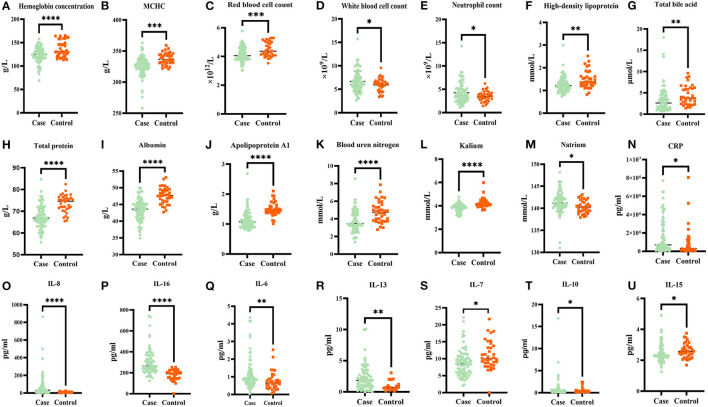Network Association of Biochemical and Inflammatory Abnormalities With Psychiatric Symptoms in First-Episode Schizophrenia Patients
biochemical index;cardiovascular risk factors;electrochemiluminescent immunoassay;inflammation cytokine;schizophrenia LabEX支持文献- Front Psychiatry
- 2022
- 3.2
- 13:834539.
- Human
- MSD
- 神经系统
- Plasma
- 神经系统
- 精神分裂症
- doi: 10.3389/fpsyt.2022.834539
Abstract
Methods: A total of 115 participants, including 79 first-episode drug-naïve patients with SCZ and 36 healthy controls, were enrolled in this study. Semi-structured interviews were used to collect sociodemographic data, family history of SCZ, and medical and psychiatric history. The Brief Psychiatric Rating Scale (BPRS) and the Positive and Negative Syndrome Scale (PANSS) were administered by a clinical psychiatrist to evaluate the symptom severity of patients with SCZ. Plasma inflammatory cytokines were measured by a fully automated electrochemiluminescent immunoassay (Meso Scale Discovery).
Results: Blood routine, biochemical, and inflammation cytokine test results showed that the levels of white blood cell count, neutrophil count, natrium, CRP, IL-8, IL-6, IL-13, and IL-16 significantly increased in the case group than in the healthy controls (p < 0.05), whereas levels of red blood cell count, hemoglobin concentration, mean corpuscular hemoglobin concentration, total protein, albumin, total bile acid, high-density lipoprotein (HDL), apolipoprotein A1, blood urea nitrogen, kalium and IL-15 were lower than in the healthy controls (p < 0.05). Correlation network analysis results shown that the natrium, HDL and red blood cell count were the top 3 factors closely to with BPRS and PANSS related clinical symptoms among of correlation network (degree = 4). ROC curve analysis explored the IL-16, IL-8, IL-13, IL-15, natrium, and HDL had highly sensitivity and specificity to the predictive validity and effectiveness for SCZ symptoms.
Conclusion: Our study revealed a complex interactive network correlation among the cardiovascular risk factors, biological immunity profiles, and psychotic symptoms in first-episode patients. Abnormal inflammatory factors and CVD risk factors had high sensitivity and specificity for predicting SCZ symptoms. Generally, our study provided novel information on the immune-related mechanisms involved in early CVD risk in patients with psychotic disorders.
LabEx MSD平台助力探索代谢标志物对精神分裂症临床症状的影响
本周为大家带来的文献为发表于Front Cell Dev Biol. (IF: 5.5)的” Structural and Functional Dysbiosis of Fecal Microbiota in Chinese Patients With Alzheimer's Disease”。本文使用了LabEx提供的MSD检测服务。
精神障碍患者可能会出现心血管疾病(CVD)风险因素,如血脂异常和全身异常炎症过程,这可能会导致死亡率升高。免疫和代谢标志物之间的相互作用及其对精神分裂症(SCZ)临床症状的影响仍不清楚。本研究旨在探讨一系列炎症因子,血浆生化指标,SCZ 临床症状与 SCZ 症状严重程度之间的关联。
本研究共招募了115名参与者,其中包括79名首次发病且未接受过药物治疗的SCZ患者和36名健康对照者。研究采用半结构式访谈收集社会人口学数据,SCZ 家族史,病史和精神病史。临床精神科医生采用简易精神病评定量表(BPRS)和阳性与阴性综合征量表(PANSS)评估SCZ患者的症状严重程度。血浆炎症细胞因子由全自动电化学发光免疫分析仪(Meso Scale Discovery)测定。
LabEx提供的MSD检测服务:
使用MSD平台(labservice.univ-bio/LabEx,中国上海)测量炎症生物标志物[Flt-1、胎盘生长因子(PIGF)、血管生成素-2(Tie-2)、IFN-γ、TNF-α、TNF-β、C反应蛋白(CRP)、IL-1α、IL-2、IL-4、IL-5、IL-6、IL-7、IL-8、IL-10、IL-12、IL-13、IL-15、IL-16和IL-17A]的多重水平。使用 MSD sector 2100A 读取平板,并使用 MSD Discovery Workbench 4.0 软件(Meso Scale Diagnostics 公司提供)分析数据。这些炎症细胞因子的检测限为 0.01 pg/mL,所有标准品和血浆样本均重复检测。
为了研究患者与健康人之间不同的内环境稳态,研究者对血常规、生化指标和炎症细胞因子进行了测量。

精神分裂症初发药物幼稚患者与健康对照组血常规、生化因子和炎症细胞因子浓度的比较
重要发现:
血常规,生化和炎症细胞因子检测结果显示,病例组的白细胞计数,中性粒细胞计数,Natrium,CRP,IL-8,IL-6,IL-13和IL-16水平明显高于健康对照组(P < 0. 05),而红细胞计数,血红蛋白浓度,平均血红蛋白浓度,总蛋白,白蛋白,总胆汁酸,高密度脂蛋白(HDL),脂蛋白 A1,血尿素氮,钙和 IL-15 的水平低于健康对照组(P < 0.05)。相关性网络分析结果表明,在相关性网络中,与 BPRS 和 PANSS 相关临床症状密切相关的前 3 个因素是钙离子,高密度脂蛋白和红细胞计数(度数 = 4)。ROC曲线分析显示,IL-16,IL-8,IL-13,IL-15,纳特利姆和高密度脂蛋白对SCZ症状的预测有效性和特异性都很高。
本网站销售的所有产品及服务均不得用于人类或动物之临床诊断或治疗,仅可用于工业或者科研等非医疗目的。











 沪公网安备31011502400759号
沪公网安备31011502400759号
 营业执照(三证合一)
营业执照(三证合一)


